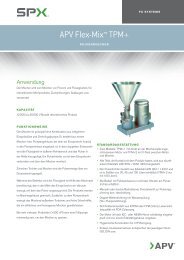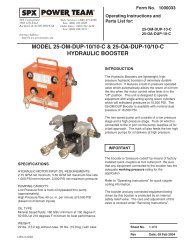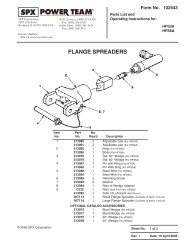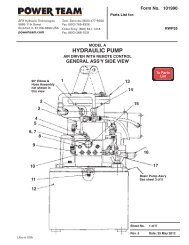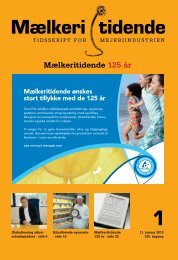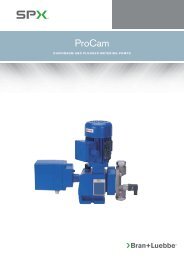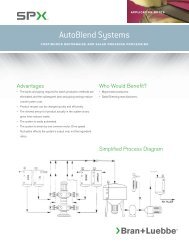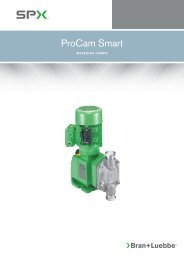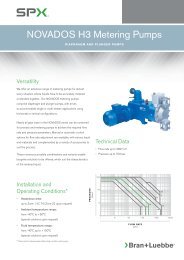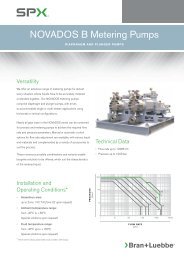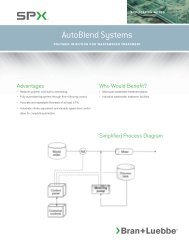SPX Flow Technology Innovation Centre
SPX Flow Technology Innovation Centre
SPX Flow Technology Innovation Centre
Create successful ePaper yourself
Turn your PDF publications into a flip-book with our unique Google optimized e-Paper software.
SafeWater<br />
<strong>SPX</strong> <strong>Flow</strong> <strong>Technology</strong> <strong>Innovation</strong> <strong>Centre</strong><br />
Originally developed for the production of chlorine in swimming pools, electrolysis technology has been advanced to enable the<br />
production of valuable cleaning and sanitising solutions. When sodium chloride is subjected to electrolysis with a dividing membrane<br />
between the electrodes, two separate solutions are produced. These are primarily hypochlorous acid and sodium hydroxide at the<br />
anode and cathode respectively.<br />
Hypochlorous acid is powerful sanitiser and cleaning agent and is substantially more effective than hypochlorite. The soil removal<br />
process is fast and effective without the need for heating.<br />
This new technology revolutionises CIP and sanitation procedures. It assists in reducing the carbon footprint, saves energy and the<br />
costs of expensive formulated chemicals.<br />
FUNDAMENTALS OF SAFEWATER<br />
Electrolysis of common salt with a dividing membrane between the electrodes results in two separate solutions suitable for sanitation<br />
(Anolyte) and CIP (Catholyte) – hypochlorous acid (HOCL) and sodium hydroxide (NaOH) being the main constituents. Hypochlorous<br />
acid, a weak acid that also occurs naturally in the body to combat infection, is a powerful sanitiser and cleaning agent that is substan-<br />
tially more effective than hypochlorite. It sanitises rapidly and effectively without the need for heating. This new technology revolution-<br />
ises CIP procedures. It helps reduce carbon footprint, shortens changeover time and saves energy as well as the costs of expensive,<br />
formulated chemicals. The process of deposit removal is fast and effective without the need for heating. However, when dealing with<br />
heavy mineral deposits and pronounced fouling it may be necessary to complement with traditional CIP procedures.<br />
The fundamentals of using natural drinking water with just a bit of food salt added and applying an electrical current to produce a<br />
natural disinfectant that is identical with nature’s own have elevated the status of natural disinfection in the dairy, food and beverage<br />
industries as an environmentally friendly solution.<br />
The fact that the process is based upon simple electrolysis using only natural ingredients such as water and salt means that SafeWater<br />
is a truly sustainable solution.<br />
Water Salt<br />
+ + Electricity SafeWater<br />
+<br />
Generator<br />
Fig. 1: Fundamentals of SafeWater technology<br />
Electrolysed<br />
Water<br />
22 9004-06-09-2012-GB



